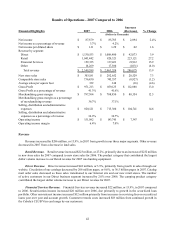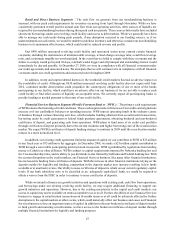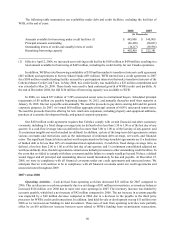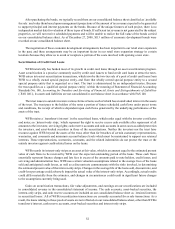Cabela's 2008 Annual Report Download - page 57
Download and view the complete annual report
Please find page 57 of the 2008 Cabela's annual report below. You can navigate through the pages in the report by either clicking on the pages listed below, or by using the keyword search tool below to find specific information within the annual report.52
After purchasing the bonds, we typically record them on our consolidated balance sheet classified as “available
for sale” and value them based upon management’s projections of the amount of tax revenue expected to be generated
to support principal and interest payments on the bonds. Because of the unique features of each project, there is no
independent market data for valuation of these types of bonds. If sufficient tax revenue is not generated by the subject
properties, we will not receive scheduled payments and will be unable to realize the full value of the bonds carried
on our consolidated balance sheet. As of December 27, 2008, $113 million of economic development bonds were
recorded on our consolidated balance sheet.
The negotiation of these economic development arrangements has been important to our retail store expansion
in the past, and these arrangements may be an important factor in our retail store expansion strategy in certain
locations because they allow us to avoid or recapture a portion of the costs involved with opening a new store.
Securitization of Credit Card Loans
WFB historically has funded most of its growth in credit card loans through an asset securitization program.
Asset securitization is a practice commonly used by credit card issuers to fund credit card loans at attractive rates.
WFB enters into asset securitization transactions, which involve the two-tier sale of a pool of credit card loans from
WFB to a wholly owned special purpose entity, and from that wholly owned special purpose entity to a second
special purpose entity that is organized as a trust. The trust is administered by an independent trustee. Because
the trust qualifies as a “qualified special purpose entity” within the meaning of Statement of Financial Accounting
Standards No. 140, Accounting for Transfers and Servicing of Financial Assets and Extinguishments of Liabilities
(“FAS 140”), its assets and liabilities are not consolidated in our balance sheet in accordance with FAS 140.
The trust issues to outside investors various forms of notes each of which has an undivided interest in the assets
of the trust. The trust pays to the holders of the notes a portion of future scheduled cash flows under preset terms
and conditions, the receipt of which is dependent upon cash flows generated by the underlying performance of the
assets of the trust.
WFB retains a “transferor’s interest” in the securitized loans, which ranks equal with the investor certificates
and notes; an “interest-only strip,” which represent the right to receive excess cash available after repayment of all
amounts to the investors; servicing rights; cash reserve accounts and cash accounts in some cases as added protection
for investors, and asset-backed securities in three of the securitizations. Neither the investors nor the trust have
recourse against WFB beyond the assets of the trust, other than for breaches of certain customary representations,
warranties, and covenants and minimum account balance levels which must be maintained to support our retained
interests. These representations, warranties, covenants, and the related indemnities do not protect the trust or the
outside investors against credit-related losses on the loans.
WFB records its interest-only strips as an asset at fair value, which is an amount equal to the estimated present
value of cash flows to be received by WFB over the expected outstanding period of the loans. These cash flows
essentially represent finance charges and late fees in excess of the amounts paid to note holders, credit losses, and
servicing and administration fees. WFB uses certain valuation assumptions related to the average lives of the loans
sold and anticipated credit losses, as well as a discount rate commensurate with the risks involved, in determining
the estimated present value of the interest-only strips. Changes in the average life of the loans sold, discount rate, and
credit-loss percentage could adversely impact the actual value of the interest-only strips. Accordingly, actual results
could differ materially from the estimates, and changes in circumstances could result in significant future changes
to the assumptions currently being used.
Gains on securitization transactions, fair value adjustments, and earnings on our securitizations are included
in consolidated revenue in the consolidated statement of income. The cash accounts, asset-backed securities, the
interest-only strips, and cash reserve accounts are included on our consolidated balance sheet as “retained interests
in securitized loans.” All of WFB’s securitization transactions are currently accounted for as sale transactions. As a
result, the loans relating to those pools of assets are not reflected on our consolidated balance sheet, other than WFB’s
transferor’s interest, cash reserve accounts, asset-backed securities and interest-only strips.
























